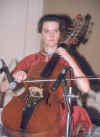|
|
the-south-asian.com February 2003 |
||||
|
FEBRUARY 2003 Contents Music Cello in
Indian
In News South Asian voice at Siblings - achievers
Serialisation
of 'Knock at every alien Events Cricket World Cup Lehngas - a limited collection Books
|
|
||||
|
CELLO IN INDIAN CLASSICAL MUSIC by Isidore Domnick Mendis
Saskia's musical journey began in Amsterdam under the guidance of the late cello virtuoso Tibor de Machula. Today she is the only artist in the world who has adapted this western instrument to Indian music and her performances usually end with standing ovations.
Ever since she was a little kid living in Amsterdam Saskia grew up listening to the soft strains of the cello, which her grandfather played. By eight when most young girls play with dolls, Saskia began her own musical journey under the guidance of the late cello virtuoso Tibor de Machula. While doing a course in ethnomusicology at the Amsterdam University she happened to attend a session of north Indian classical music. " It was like a powerful magnet and it pulled me towards it. I suddenly felt the urge to create Indian music on the cello," says the Dutch woman who was recently on one of her frequent visits to Delhi. She enrolled as a student at the Conservatory of Rotterdam, which had two eminent Indians as visiting professors---Koustav Ray and Pandit Hariprasad Chaurasia. During her subsequent visits to India she also studied under well-known gurus like Dr. Sumati Mutatkar, Pandit D.K. Datar and Deepak Chowdhury.
Incidentally, cello is also one of Pandit Ravi Shankar’s most loved instruments. Says Shubendra, " When he came to know of our decision to marry, Pandit Ravi Shankar told me I was marrying someone who played his favourite musical instrument." The first thing Saskia did after marriage was to adapt the cello to north Indian classical music. The new cello has five playing strings and ten resonant strings whereas a normal cello has four playing strings and no resonant strings. Secondly, the size is a bit smaller. Musical Traditions In addition to their solo careers, Saskia and Shubhendra do their own compositions based on different Indian and Western musical traditions when they perform together. " Our music is different from pure Indian classical music. The cello and sitar have never combined like the way we are doing it. Secondly, our compositions are based on folk music of different regions of India and Europe. That's why our music appeals to all type of people," says Shubhendra whose famous sitarist father N. R. Rama Rao was also a disciple of Pandit Ravi Shankar. Recently the couple performed in Delhi and the response was overwhelming. Such was the stirring performance that many in the audience were moved to tears. Saskia's schedule is chockfull with performances in India and in Europe. Her varied experiences also include collaborations with South Indian musicians as well as Klezmer, Flamenco and other European folk musicians. She has conducted workshops and lecture-demonstrations at universities and conservatories in Holland. " Cello is one of the most important musical instruments in western classical music. In every jazz and symphony orchestra cello plays a very vital role. Violin, viola, cello and double bass make the complete family of violin," Says Saskia. Like other Indian classical musicians, Saskia is keen to introduce cello to Indian films. But before any Bollywood producer responds, the two are going on a trans-Atlantic tour and are also releasing a joint album. Saskia says she is not a fusion artist who is bringing Western and Indian classical music together. " I am simply playing Indian music with cello. I have tried to adapt a western classical instrument to Indian music. I would like to be remembered as someone who created a place for the cello in the Indian classical music."
******
|
|||||
| Copyright © 2000 - 2003 [the-south-asian.com]. Intellectual Property. All rights reserved. | |||||
| Home | |||||

